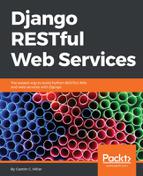Our RESTful Web Service has to be able to serialize and deserialize the Toy instances into JSON representations. In Django REST framework, we just need to create a serializer class for the Toy instances to manage serialization to JSON and deserialization from JSON. Now, we will dive deep into the serialization and deserialization process in Django REST framework. It is very important to understand how it works because it is one of the most important components for all the RESTful Web Services we will build.
Django REST framework uses a two-phase process for serialization. The serializers are mediators between the model instances and Python primitives. Parser and renderers handle as mediators between Python primitives and HTTP requests and responses. We will configure our mediator between the Toy model instances and Python primitives by creating a subclass of the rest_framework.serializers.Serializer class to declare the fields and the necessary methods to manage serialization and deserialization.
We will repeat some of the information about the fields that we have included in the Toy model so that we understand all the things that we can configure in a subclass of the Serializer class. However, we will work with shortcuts, which will reduce boilerplate code later in the following examples. We will write less code in the following examples by using the ModelSerializer class.
Now, go to the restful01/toys folder and create a new Python code file named serializers.py. The following lines show the code that declares the new ToySerializer class. The code file for the sample is included in the hillar_django_restful_02_01 folder in the restful01/toys/serializers.py file:
from rest_framework import serializers
from toys.models import Toy
class ToySerializer(serializers.Serializer):
pk = serializers.IntegerField(read_only=True)
name = serializers.CharField(max_length=150)
description = serializers.CharField(max_length=250)
release_date = serializers.DateTimeField()
toy_category = serializers.CharField(max_length=200)
was_included_in_home = serializers.BooleanField(required=False)
def create(self, validated_data):
return Toy.objects.create(**validated_data)
def update(self, instance, validated_data):
instance.name = validated_data.get('name', instance.name)
instance.description = validated_data.get('description', instance.description)
instance.release_date = validated_data.get('release_date', instance.release_date)
instance.toy_category = validated_data.get('toy_category', instance.toy_category)
instance.was_included_in_home = validated_data.get('was_included_in_home', instance.was_included_in_home)
instance.save()
return instance
The ToySerializer class declares the attributes that represent the fields that we want to be serialized. Notice that we have omitted the created attribute that was present in the Toy model. When there is a call to the save method that ToySerializer inherits from the serializers.Serializer superclass, the overridden create and update methods define how to create a new instance or update an existing instance. In fact, these methods must be implemented in our class because they only raise a NotImplementedError exception in their base declaration in the serializers.Serializer superclass.
The create method receives the validated data in the validated_data argument. The code creates and returns a new Toy instance based on the received validated data.
The update method receives an existing Toy instance that is being updated and the new validated data in the instance and validated_data arguments. The code updates the values for the attributes of the instance with the updated attribute values retrieved from the validated data. Finally, the code calls the save method for the updated Toy instance and returns the updated and saved instance.
